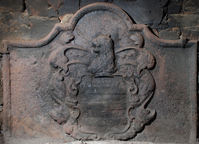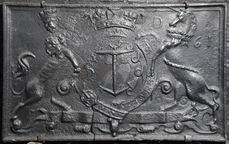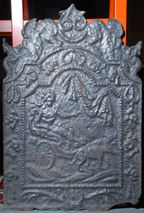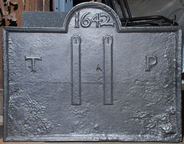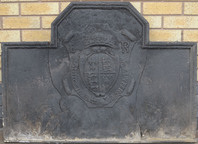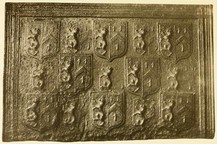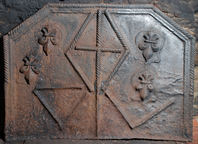-
812
 ? x ? mm
? x ? mmDescription: Canted rectangle; twisted rope edging (top and sides); divided by rope lengths into four panels: centre top, square; centre bottom, trapezium; sides, irregular hexagons; buckle stamp repeated three times, in bottom and side panels; top centre panel, circular flower stamp with fleur de lys on each petal.
Notes: The buckle stamps suggest a connection with the Pelham family; illustrated in Butterfield 1916, where it was stated to have been in a house at Herstmonceux, Sussex..
- Decoration tags:
- rectangular with canted top corners (shape)
- rope (edging)
- simple stamps
- carved stamps
- planklines
- heraldic
- objects
Manufactured: in the late-16th century in the Weald area of England.
Current location: not known.
Citation: Butterfield, W. R., 1916, 'Old Wealden Firebacks', The Connoisseur, 46, pp. 197-209.
- Attached to series:
- Pelham family firebacks
- Metalware stamp firebacks
-
913
Description: Rectangular with an arched rectangular style arch linked by symmetrical concave curves; ovolo moulding (top and sides); shield, helm, crest and mantling of the Fuller family. A number 7, the only visible part of the date seen on other castings is in the top right corner of the shield.
Notes: A carved armorial on a plain, edged base board; the arms of the Fullers of Brightling Park, Sussex: Argent, three bars and a canton gules; the crest; Out of a ducal coronet Or, a lion’s head argent; the Fullers were iron masters and gun founders in the first half of the 18th century, operating Heathfield furnace, where it is likely that this fireback was cast.
Inscription: [1] 7 / [4] [7]
Arms: Fuller, of Brightling, Sussex
- Decoration tags:
- rectangular with round arch (shape)
- ovolo (edging)
- carved pattern panels
- armorial
Manufactured: in 1747 probably at Heathfield Furnace in the Weald area of England.
Current location: in private hands, Brightling, East Sussex, England.
- Attached to series:
- Ironmasters armorial series
- Personal armorial firebacks
-
220
Description: Rectangular with cavetto moulded edging; English Royal supporters (crowned lion and unicorn) standing upon a cartouche, upon which rests a blank motto scroll; above, an anchor, surrounded by a looped cable is encircled by the Garter ribbon, which is surmounted by a royal coronet; the numbers ‘61’, presumably part of the date, are to the right of the unicorn, and a letter, ‘D’, is placed between the unicorn and the coronet.
Notes: From another casting of the same back, the date is known to be 1661. The cabled anchor is the badge of the Lord High Admiral who, in 1661, was the Duke of York and Albany, later James II. The missing initial is an ‘I’, for Jacobus Dux. The absence of the motto may be explained by the pattern being a carved armorial panel where the motto text, unlike that of the Garter, was merely painted.
Copies of this fireback are known.
Inscription: [I] D / 16 61
Arms: Lord High Admiral of England
- Decoration tags:
- rectangular (shape)
- cavetto (edging)
- whole carved pattern
- individual letters
- individual numbers
- armorial
- text
Manufactured: in 1661 possibly in the Weald area of England.
Current location: Preston Manor, Brighton, East Sussex, England.
Museum number: PM400269 (part of the Brighton Museum museum group)
- Attached to series:
- Miscellaneous royal firebacks
-
215
Description: Arched rectangular central panel with canted, cavetto-canted shoulders and bead edging on a broad fillet; seated female figure in a chariot drawn by dogs, symmetrical hanging drapery above right; same-shaped border with fillet edging at top, and suspended ribbons with floral bunches; at base, symmetrical palm leaves tied with ribbon; symmetrical serpents on top their tails intertwined.
Notes: The design is derived from a personification of America, one of a set of playing cards entitled Jeu de la Géographie, designed by Stefano della Bella (1677). The pattern for this fireback, from which the protuberances above the serpents’ heads is missing, is in Rottingdean Grange (no. 930). The pattern, however, has a base panel of a chain-link design, which is missing from this casting.
Copies of this fireback are known.
- Decoration tags:
- 'Dutch' (shape)
- fillet (edging)
- whole carved pattern
- planklines
- pictorial
- allegorical
- animals
- humans
- objects
Manufactured: in the late-17th to early-18th century possibly in the Weald area of England.
Current location: Brighton Museum and Art Gallery, Brighton, East Sussex, England.
Museum number: HATMP002214 (part of the Brighton Museum museum group)
- Attached to series:
- Mayfield 'Dutch' series
- British 'Dutch' style firebacks
-
217
Description: Arched rectangular shape; ovolo edging; date in arch; below arch, two parallel straps, each with a buckle at the top; initials left and right of centre; rectangular stamp with bird, four times across top.
Notes: The buckles, the date and the initials all appear to be separate stamps but attached to the base board before being impressed to form the mould, as they are identically positioned on all castings. The buckles suggest a connection with the Pelham family; the initials may relate to Sir Thomas Pelham, Bt. (1597-1654) who owned and operated ironworks at Waldron and Crowhurst in Sussex. This would appear to be a casting of the original pattern.
Copies of this fireback are known.
Inscription: 1642 / T P
- Decoration tags:
- rectangular with round arch (shape)
- ovolo (edging)
- whole carved pattern
- individual numbers
- planklines
- text
- objects
Manufactured: in 1642 probably at Waldron Furnace in the Weald area of England.
Current location: Brighton Museum and Art Gallery, Brighton, East Sussex, England.
Museum number: HA105912 (part of the Brighton Museum museum group)
Citation: Lindsay, J. S., 1927, Iron & Brass Implements of the English House (London, The Medici Society).
- Attached to series:
- 1642 Pelham series
- Pelham family firebacks
-
218
Description: Rectangular; cyma recta moulded edging formed of short lengths probably derived from furniture; top left, initials arranged in triad; top right, date; top centre, rose-and-crown between two small fleurs de lys, with two concentric rope-patterned roundels outside, above two small roses; four roses evenly spaced across lower middle, with a fleur between each outer pair, and another rose below the date.
Notes: One of a series of firebacks cast between the 1670s and 1690s bearing small, simple stamps, initials and dates; the style of rose and crown is similar to that used in gun founding in the Tudor period, suggesting that the furnace that was the source of this fireback may have been used for that purpose.
Inscription: HEM [triad] 1685
- Decoration tags:
- rectangular (shape)
- complex, furniture-derived (edging)
- simple stamps
- carved stamps
- individual letters
- individual numbers
- heraldic
- royal
- text
- objects
Manufactured: in 1685 in the Weald area of England.
Current location: Brighton Museum and Art Gallery, Brighton, East Sussex, England.
Museum number: R3341/2 (part of the Brighton Museum museum group)
Citation: Gardner, J. S., 1898, 'Iron Casting in the Weald', Archaeologia, 56, 1, pp. 133-164.
Citation: Lindsay, J. S., 1927, Iron & Brass Implements of the English House (London, The Medici Society).
- Attached to series:
- 1660s-90s Wealden series
- Fleur-de-lys firebacks
-
175
Description: Quasi-arched rectangular with 5-facetted arch; cyma recta moulded edging (top and sides); in the centre, an oval Tudor royal shield on a cartouche surrounded by a garter, a crown above, separating the initials, ER, all on a larger cartouche.
Notes: An example at Chiddingstone in Kent has additional circular, crowned armorial stamps, linking it to firebacks dating fron 1589. Brightwells auction, Leominster, 16 Mar 2016, lot 704 (£220).
Copies of this fireback are known.
Inscription: E / HONI SOIT QVI MAL Y PENCE / R
Arms: Tudor royal (Elizabeth I)
- Decoration tags:
- rectangular with five-facetted arch (shape)
- cyma recta (edging)
- carved stamps
- planklines
- armorial
- royal
- text
Manufactured: in the late-16th century in the Weald area of England.
Current location: not known.
- Attached to series:
- 1589 series
- Tudor royal armorial firebacks
-
202
Description: Rectangular; edging formed from furniture moulding; shield of Ayloffe impaling Sulyard impressed weakly seven times (2-3-2), with the same shield impressed eight times (3-2-3), more deeply, in the spaces between the first shields.
Notes: William Ayloffe (c1535-1584) of Bretons, Hornchurch, Essex, Justice of the Court of Queen’s Bench, married (c1560) Jane, dau. of Sir Eustace Sulyard, of Runwell, Essex. A large number of variants use the same shields. Several copies are known of this fireback, but in precisely the same arrangement, all poorly cast, unlike the variants without the additional shields, which are found in many different arrangements, some with dates and initials. From an illustration in the catalogue of an exhibition on heraldry at Burlington House, London, in 1894, it then being at Manor Farm, Edenbridge, Kent.
Copies of this fireback are known.
Arms: Ayloffe impaling Sulyard (William Ayloffe of Bretons, Hornchurch)
- Decoration tags:
- rectangular (shape)
- complex, furniture-derived (edging)
- carved stamps
- heraldic
- armorial
Manufactured: in the early-17th century in the Weald area of England.
Current location: not known.
- Attached to series:
- Ayloffe series
- Personal armorial firebacks
-
29
Description: Rectangular; cavetto moulded edging; initials in top left corner; date in top right corner.
Notes: The style of lettering and numerals is reminiscent of those seen on firebacks associated with the Sidneys, Earls of Leicester, and may suggest a common source.
Inscription: IB 1695
- Decoration tags:
- rectangular (shape)
- cavetto (edging)
- individual letters
- individual numbers
- text
Manufactured: in 1695 possibly in the Weald area of England.
Current location: Bateman's, Burwash, East Sussex, England.
Museum number: 761128 (part of the National Trust museum group)
- Attached to series:
- Date & initials firebacks
-
826
Description: Canted rectangular shape with moulded edging (top and sides) overlain by a length of twisted rope repeated six times; central vertical line formed of twisted rope, crossed with rope upper centre, with rope laid in a diamond pattern around the cross; lower centre, two irregular v-shapes formed of rope, one on each side of the vertical; shield shaped stamp with a fleur de lys repeated twice each side, upper left and right.
Notes: The twin V arrangement may have apotropaic significance and the cross above them having a Christian symbolism; the base board appears to have had a moulded edge, with rope lengths applied over part of the moulding after the board had been pressed into the casting bed; a sketch of this fireback was made by J. Starkie Gardner c.1891 and is in his collection at the Victoria and Albert Museum, Archive of Art and Design (AAD/2014/8).
- Decoration tags:
- rectangular with canted top corners (shape)
- rope over moulding (edging)
- simple stamps
- carved stamps
- heraldic
- apotropaic
- objects
Manufactured: in the late-16th century in the Weald area of England.
Current location: in private hands, Burwash, East Sussex, England.
- Attached to series:
- Miscellaneous stamp firebacks
- Rope design firebacks
- Fleur-de-lys firebacks
